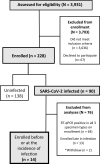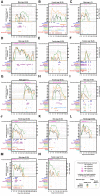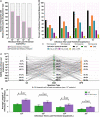Extreme differences in SARS-CoV-2 viral loads among respiratory specimen types during presumed pre-infectious and infectious periods
- PMID: 36926220
- PMCID: PMC10013338
- DOI: 10.1093/pnasnexus/pgad033
Extreme differences in SARS-CoV-2 viral loads among respiratory specimen types during presumed pre-infectious and infectious periods
Abstract
SARS-CoV-2 viral-load measurements from a single-specimen type are used to establish diagnostic strategies, interpret clinical-trial results for vaccines and therapeutics, model viral transmission, and understand virus-host interactions. However, measurements from a single-specimen type are implicitly assumed to be representative of other specimen types. We quantified viral-load timecourses from individuals who began daily self-sampling of saliva, anterior-nares (nasal), and oropharyngeal (throat) swabs before or at the incidence of infection with the Omicron variant. Viral loads in different specimen types from the same person at the same timepoint exhibited extreme differences, up to 109 copies/mL. These differences were not due to variation in sample self-collection, which was consistent. For most individuals, longitudinal viral-load timecourses in different specimen types did not correlate. Throat-swab and saliva viral loads began to rise as many as 7 days earlier than nasal-swab viral loads in most individuals, leading to very low clinical sensitivity of nasal swabs during the first days of infection. Individuals frequently exhibited presumably infectious viral loads in one specimen type while viral loads were low or undetectable in other specimen types. Therefore, defining an individual as infectious based on assessment of a single-specimen type underestimates the infectious period, and overestimates the ability of that specimen type to detect infectious individuals. For diagnostic COVID-19 testing, these three single-specimen types have low clinical sensitivity, whereas a combined throat-nasal swab, and assays with high analytical sensitivity, was inferred to have significantly better clinical sensitivity to detect presumed pre-infectious and infectious individuals.
Keywords: COVID-19; testing strategies; viral loads.
© The Author(s) 2023. Published by Oxford University Press on behalf of National Academy of Sciences.
Figures







Similar articles
-
Daily SARS-CoV-2 Nasal Antigen Tests Miss Infected and Presumably Infectious People Due to Viral Load Differences among Specimen Types.Microbiol Spectr. 2023 Aug 17;11(4):e0129523. doi: 10.1128/spectrum.01295-23. Epub 2023 Jun 14. Microbiol Spectr. 2023. PMID: 37314333 Free PMC article.
-
Quantitative SARS-CoV-2 Viral-Load Curves in Paired Saliva Samples and Nasal Swabs Inform Appropriate Respiratory Sampling Site and Analytical Test Sensitivity Required for Earliest Viral Detection.J Clin Microbiol. 2022 Feb 16;60(2):e0178521. doi: 10.1128/JCM.01785-21. Epub 2021 Dec 15. J Clin Microbiol. 2022. PMID: 34911366 Free PMC article.
-
Quantitative SARS-CoV-2 viral-load curves in paired saliva and nasal swabs inform appropriate respiratory sampling site and analytical test sensitivity required for earliest viral detection.medRxiv [Preprint]. 2021 Aug 26:2021.04.02.21254771. doi: 10.1101/2021.04.02.21254771. medRxiv. 2021. Update in: J Clin Microbiol. 2022 Feb 16;60(2):e0178521. doi: 10.1128/JCM.01785-21. PMID: 33851180 Free PMC article. Updated. Preprint.
-
Upper respiratory tract sampling in COVID-19.Malays J Pathol. 2020 Apr;42(1):23-35. Malays J Pathol. 2020. PMID: 32342928 Review.
-
Diagnosis of SARS-Cov-2 Infection by RT-PCR Using Specimens Other Than Naso- and Oropharyngeal Swabs: A Systematic Review and Meta-Analysis.Diagnostics (Basel). 2021 Feb 21;11(2):363. doi: 10.3390/diagnostics11020363. Diagnostics (Basel). 2021. PMID: 33670020 Free PMC article. Review.
Cited by
-
The ratio between SARS-CoV-2 RNA viral load and culturable viral titre differs depending on the stage of infection: a case study of household transmission in an adult male.Access Microbiol. 2025 Feb 17;7(2):000732.v3. doi: 10.1099/acmi.0.000732.v3. eCollection 2025. Access Microbiol. 2025. PMID: 39967741 Free PMC article.
-
Validating Combination Throat-Nasal Swab Specimens for COVID-19 Tests Would Improve Early Detection, Especially for the Most Vulnerable.Clin Infect Dis. 2024 Oct 15;79(4):815-818. doi: 10.1093/cid/ciae381. Clin Infect Dis. 2024. PMID: 39041943 Free PMC article.
-
COVID-19 study quantifying daily viral loads confirms throat samples are key to early diagnosis.Diagn Microbiol Infect Dis. 2025 Apr;111(4):116742. doi: 10.1016/j.diagmicrobio.2025.116742. Epub 2025 Feb 13. Diagn Microbiol Infect Dis. 2025. PMID: 39965480 No abstract available.
-
Molecular Detection of SARS-CoV-2 From Throat Swabs Performed With or Without Specimen Collection From the Tonsils: Protocol for a Multicenter Randomized Controlled Trial.JMIR Res Protoc. 2024 Jun 12;13:e47446. doi: 10.2196/47446. JMIR Res Protoc. 2024. PMID: 38865190 Free PMC article.
-
Prevalence of persistent SARS-CoV-2 in a large community surveillance study.Nature. 2024 Feb;626(8001):1094-1101. doi: 10.1038/s41586-024-07029-4. Epub 2024 Feb 21. Nature. 2024. PMID: 38383783 Free PMC article.
References
-
- NIH . 2021. Therapeutic Management of Adults With COVID-19. https://www.covid19treatmentguidelines.nih.gov/therapeutic-management/.
LinkOut - more resources
Full Text Sources
Miscellaneous

